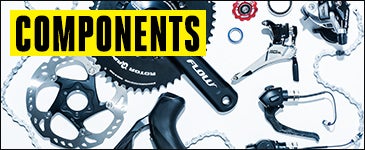2015 Triathlete Buyer's Guide: Components

$89, Ultrafastoptimization.com
The draw: Newfound speed saver
UltraFast takes a standard chain and strips the factory coating, retreating it with a paraffin wax and Teflon PTFE powder application. This time-intensive, 21-step process results in a power savings of about 2 percent, according to Ultra Fast’s research. The downside is that the coating only lasts for about 200 miles. While $89 may seem exorbitant for a chain, it’s a bargain considering the potential speed boost on race day.
$650 (rings not included), Rotorbike.com
The draw: Uncompromising aerodynamics
Rotor dubs the Flow crankset as a paradigm-shifting component because it increases speed without adding much weight or decreasing stiffness. While it does weigh slightly more than Rotor’s 3D+ cranks at 562 grams without chainrings, it can save precious time over the course of a triathlon by creating a smooth surface for air to pass over. Several wind tunnel tests have proven that aero cranks can make a significant difference. The solid spider has two sets of bolt holes, which allows for fine adjustment of Rotor’s elliptical Q-Rings.
$2,400, Shimano.com
The draw: Superb stopping control
If you already have your race rig and need a second bike for training, especially in less-than-ideal conditions, this is the very best component kit despite the second-level Ultegra label. Disc brakes on road bikes offer consistent braking power in any conditions. Shimano has nearly perfected the technology on its mountain components and brings much of the same technology to this road system. Stopping control and power is incredible. Mated to class-leading electronic shifting, this kit is killer over any terrain in any weather.
$1,307 (Shimano 11s Pulley Wheels, Zipp-4 wheel kit and BB30 bearings, all sold separately), Ceramicspeed.com
The draw: More speed and durability
According to CeramicSpeed, the decreased friction resulting from swapping pulley wheels, hubs and bottom bracket bearings can save 6–9 watts over stock setups. Not only do they save energy, these bearings will last longer than stock versions. At $269, the aluminum Shimano pulley set costs more than a Dura-Ace 9000 mechanical rear derailleur, but the pulleys are designed to keep the chain in its ideal line to improve shifting performance while greatly reducing the drag of standard pulley wheels. Boost the efficiency of your wheels with the bearing upgrade kit, which CeramicSpeed claims will last 3–5 times longer than standard bearings.
$887, Sram.com
The draw: High function, low price
Whether you’re chasing a PR or looking forward to your first finish line, components are a place you can save money without sacrificing speed. The newest Rival 22 groupset receives the much-improved front shifting technology originally introduced in SRAM’s top-tier component group. Crisper and more reliable front shifts are the rewards, and Rival’s brake and shift control are good enough for any professional. If you’re on a budget, Rival 22 offers most of the triathlon performance of a premier mechanical groupset for hundreds less.
$4,963, Campagnolo.com
The draw: Precise, intuitive shifting
Campagnolo’s electronic bar-end shifters have a lever that shifts the derailleur almost instantly with a tiny flick as opposed to the buttons found on Shimano’s system. The shift buttons on the brake levers are further apart than the buttons on Di2 to eliminate the chance of miss-shifts. Hold down one of the buttons and Campy’s Multi-Shift technology allows the rear derailleur to run through 11 gears in less than 1.5 seconds. Aero chainrings integrated with the crank arm provide a meticulously smooth surface to slide through passing air.
[buy-now-btn nytro=”http://www.nytro.com/campagnolo/super-record-eps-front-derailleur-8633″]